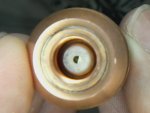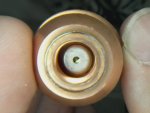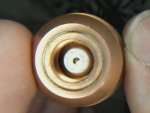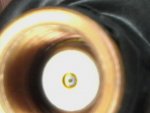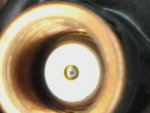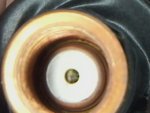Hey, that was me that burned my ceiling fan blades!

Give credit where credit is due!!!

BTW, the smell is horrendous!
I've successfully "decanned" many a diode using a rather unconventional method. I'm the type who always tries different lenses, even taking precautions while removing/installing lenses sometimes crap will get on the window, with most diodes if you see a distorted output quickly turn off power, if you were quick you can usually swipe the offending crud off with a clean toothpick(yes toothpick) and still have clean output. These diodes are a different beast, the power density is such that anything on the window that gets hit with the output will immediately heat up to the point of melting, warping or pitting the window. At this point, you have no other option but remove the window.
I don't own the expensive "pipe cutter" type decanning tool, nor do I trust myself slowly trying to score/cut the can off at the base. What I do is use a strong, sharp pick (dental pick will work but I've improvised with other tools) to catch the edge of the window/can interface. With the diode still pressed in a module, I carefully work my way around using the pick to pry the metal upward to open up the can. I use the front edge of the module as a leverage point for the pick. At some point, the window will detach from the can. Just be careful and keep at it until it opens enough that the window can be removed by letting it fall out. I've also had the glass window break during the process, in that case be extra careful and gently shake out any broken pieces. Remember, there are many delicate bond wires inside that can break easily, also the facet of the InGaN crystal/oscillator can be easily damaged. I've done this successfully many times, surprisingly none of my diodes broke in the process.
Afterwards, I don't fool around changing lenses, not going to push my luck with getting anything on the emitter facet. I have noticed "dewindowed" diodes seem more susceptible to sudden death and degradation. My theory is the windows AR coating helps keeps back reflections in check. As most know back reflections into the facet can cause COD, especially pushing them hard as we do. It could also be issues with oxidation on the facet, after all it doesn't take much given the area that actually emits light is about the size of a few bacterium. Even the smallest imperfection on that facet will create heat and rapid degradation. It just blows my mind how so much light can come from a spot smaller than a pinhead. Lol! I remember when a 35mw 532 felt like having a light saber! I would never have dreamed we would see this much progress.
 and unless I was there there is no way I could confirm it's possible it got damaged in the mail. I was just saying mine went through hell and back before it damaged the diode. If that was directed at me
and unless I was there there is no way I could confirm it's possible it got damaged in the mail. I was just saying mine went through hell and back before it damaged the diode. If that was directed at me  I assure you I am learning about the dynamics and still have plenty of room to learn. Maybe I could be your apprentice Obi Wan?
I assure you I am learning about the dynamics and still have plenty of room to learn. Maybe I could be your apprentice Obi Wan? 





